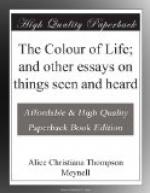A moment ago this art was declared not human. And, in fact, in no other art has the figure suffered such crooked handling. The Japanese have generally evaded even the local beauty of their own race for the sake of perpetual slight deformity. Their beauty is remote from our sympathy and admiration; and it is quite possible that we might miss it in pictorial presentation, and that the Japanese artist may have intended human beauty where we do not recognise it. But if it is not easy to recognise, it is certainly not difficult to guess at. And, accordingly, you are generally aware that the separate beauty of the race, and its separate dignity, even—to be very generous—has been admired by the Japanese artist, and is represented here and there occasionally, in the figure of warrior or mousme. But even with this exception the habit of Japanese figure-drawing is evidently grotesque, derisive, and crooked. It is curious to observe that the search for slight deformity is so constant as to make use, for its purposes, not of action only, but of perspective foreshortening. With us it is to the youngest child only that there would appear to be mirth in the drawing of a man who, stooping violently forward, would seem to have his head “beneath his shoulders.” The European child would not see fun in the living man so presented, but—unused to the same effect “in the flat”—he thinks it prodigiously humorous in a drawing. But so only when he is quite young. The Japanese keeps, apparently, his sense of this kind of humour. It amuses him, but not perhaps altogether as it amuses the child, that the foreshortened figure should, in drawing and to the unpractised eye, seem distorted and dislocated; the simple Oriental appears to find more derision in it than the simple child. The distortion is not without a suggestion of ignominy. And, moreover, the Japanese shows derision, but not precisely scorn. He does not hold himself superior to his hideous models. He makes free with them on equal terms. He is familiar with them.
And if this is the conviction gathered from ordinary drawings, no need to insist upon the ignoble character of those that are intentional caricatures.
Perhaps the time has hardly come for writing anew the praises of symmetry. The world knows too much of the abuse of Greek decoration, and would be glad to forget it, with the intention of learning that art afresh in a future age and of seeing it then anew. But whatever may be the phases of the arts, there is the abiding principle of symmetry in the body of man, that goes erect, like an upright soul. Its balance is equal. Exterior human symmetry is surely a curious physiological fact where there is no symmetry interiorly. For the centres of life and movement within the body are placed with Oriental inequality. Man is Greek without and Japanese within. But the absolute symmetry of the skeleton and of the beauty and life that cover it is accurately




